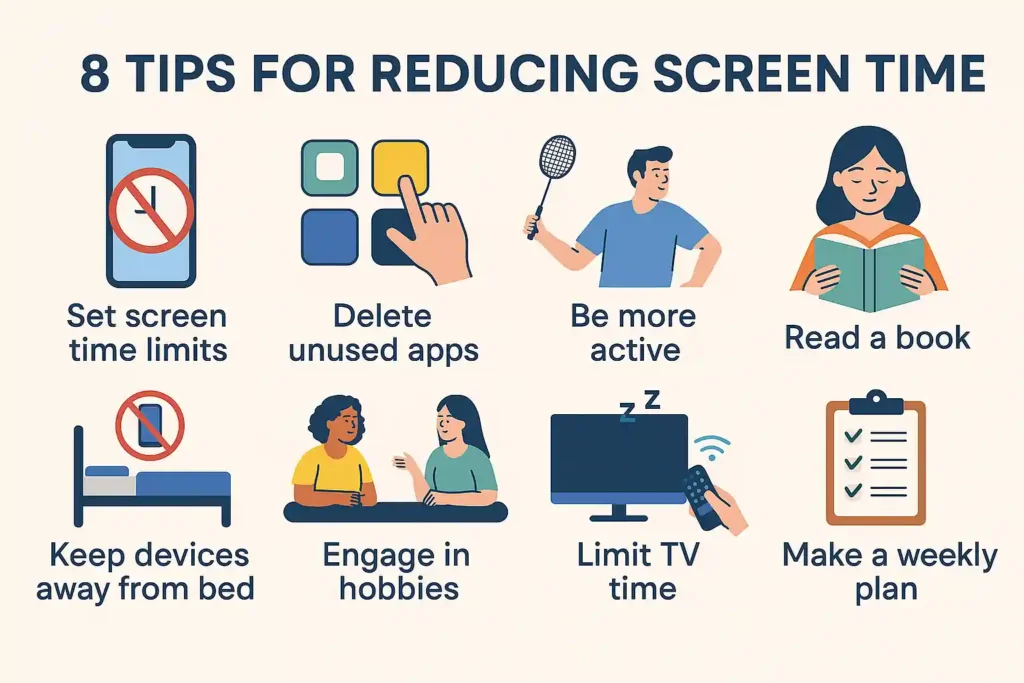How to reduce screen time is one of the biggest concerns today whether you’re a student, working adult, or parent. The average person looks at screens for around seven hours every day. That’s nearly half your day gone; just looking at phones, laptops, and TVs.
Table of Contents
ToggleToo much screen time can lead to sleep issues, poor focus, mood swings, eye strain, and even tech addiction. It creeps into your free time, relationships, and even your health.
But you don’t need to quit using your phone or computer altogether. What you really need are smart, simple, and effective tips to reduce screen time, without giving up on the things you enjoy.
Let’s break it all down into 8 easy-to-follow changes that can help you regain control of your time and life.

1. Track Your Screen Time
If you want to fix something, start by knowing what’s wrong. Tracking your usage is the first step in screen time management.
Assess the amount of time you utilize your phone on a daily basis. Your device already has a screen time report. It shows which apps take most of your time, like social media, games, or streaming platforms.
After reviewing the figures, establish a daily limit. Try cutting down 15 to 30 minutes a day. These small changes go a long way.
This is one of the most practical ways to reduce screen time because it makes you more aware of your habits.
2. Use Greyscale Mode
Greyscale turns your colorful screen black and white. It might seem strange at first, but this simple change can lower the urge to scroll endlessly.
Apps are designed with bright colors to keep you hooked. Take that away, and suddenly the feed isn’t that interesting.
This trick helps you cut back on screen time without deleting apps. It works silently in the background by making your phone less “fun” to look at.
Use greyscale during your peak screen hours to reduce phone usage.
3. Turn Off Non-Essential Notifications
Notifications are like traps. One ping, and suddenly you’ve wasted 30 minutes watching random videos or checking likes.
Go to your phone settings and turn off all unnecessary notifications; social media, shopping apps, and anything that doesn’t need your immediate attention.
Keeping only the must-haves (calls, texts, calendar) can save you hours.
This step alone can decrease screen time and help reduce screen-related anxiety caused by constant buzzing and alerts.
4. Create No-Screen Zones
You don’t need your phone during every part of the day. Start creating small no-screen zones in your routine.
Examples:
- No phones during meals
- No screen use 1 hour before bed
- No checking devices during the first 30 minutes after waking up
These blocks let your mind reset and your eyes rest. They also help break the habit of grabbing your phone out of boredom.
This is a solid method for limiting screen time and improving sleep and focus.
5. Find an Offline Hobby
Many people use screens simply because they’re bored.
Instead of reaching for your phone, fill that time with something offline, reading, painting, exercising, cooking, or going for a walk with your pet dog.
New hobbies help break bad screen time habits by giving you something meaningful and fun to do.
This is one of the best ways to use devices less and reconnect with real life.
You’ll be surprised how much you enjoy the things that don’t need Wi-Fi.
6. Talk About It
Share your goals with family or friends. Tell them you’re trying to spend less time on screens.
Ask for support or set up screen-free challenges together. This is especially helpful if you want to reduce screen time for kids too. Make it a team effort.
When others know your goals, they can hold you accountable and cheer you on.
This method creates healthy screen time boundaries for everyone in the house.
7. Use Devices Intentionally
The key to how to reduce screen time effectively is not quitting screens, it’s using them with purpose.
Ask yourself: “Why am I opening this app?” If you’re bored, take a break instead. If it’s something useful, do it and then stop.
Avoid multitasking with screens (scrolling while watching TV, texting while working). These habits increase screen fatigue and lower focus.
Be mindful. Utilize your device, complete your tasks, and move on.
Intentional use is the foundation of how to manage screen time in daily life.
8. Make Screen Time Work for You
Not all screen time is bad.
Watching educational videos, calling loved ones, reading useful articles; these can be great for your mental health and learning.
Rather than eliminating screens altogether, shift to more constructive usage. Spend more time on apps that help you grow instead of apps that waste your time.
This is one of the smartest tips to manage screen time. You don’t remove the screen, you make it work for you.
Great screen use gives no guilt.
Be Kind to Yourself
Changing habits takes time.
You might fall back into the scrolling trap sometimes. That’s okay. Don’t be too hard on yourself.
Whether you’re trying to reduce screen time for adults, teens, or kids, progress matters more than perfection.
Start small. Keep going. The goal is better habits, not punishment.
Takeaways
If you want real results, don’t overthink. Start with one small step.
Here’s a quick list of what to try right now:
- Track your screen time daily and reduce it little by little
- Switch your phone to greyscale to make it less appealing
- Turn off notifications to avoid unnecessary distractions
- Set no-screen rules during meals, bedtime, and mornings
- Replace screen time with hobbies like reading or walking
- Talk to your family about your screen time goals
- Use devices only with purpose, not out of habit
- Spend screen time on learning, not just scrolling
These are practical, tested ways to limit screen time and take back control of your day.
FAQs
How do I decrease my screen time?
Start with small changes; track your usage, turn off notifications, and build no-screen routines. It gets easier over time.
Is 7 to 8 hours screen time good?
That’s higher than recommended. Try to keep your non-work screen time below 2–3 hours daily.
How long should a 14-year-old have screen time?
Experts suggest no more than 2 hours a day outside of school-related screen use.
What age is screen time bad?
Too much screen time is harmful at any age, but it’s especially risky for children under 5 years old.
Does TV count as screen time?
Yes. Any time spent watching screens, including TVs, counts as screen time.
What age has the highest screen time?
Teens and young adults usually have the highest screen usage, especially with social media scrolling.
Is no screen time best?
Not necessarily. The goal is to create balance, not to remove screens completely.
What is the 20/20/20 rule?
To prevent blue light exposure and eye strain: Every 20 minutes, look at something 20 feet away for 20 seconds.

This article is medically reviewed by Dr. Chandril Chugh, Board-Certified Neurologist, providing expert insights and reliable health information.
Dr. Chandril Chugh is a U.S.-trained neurologist with over a decade of experience. Known for his compassionate care, he specializes in treating neurological conditions such as migraines, epilepsy, and Parkinson’s disease. Dr. Chugh is highly regarded for his patient-centered approach and dedication to providing personalized care.








